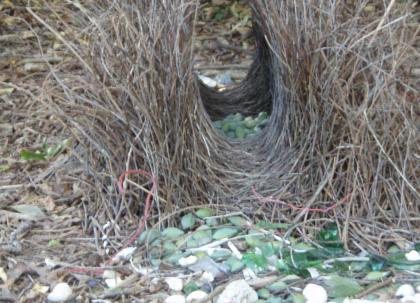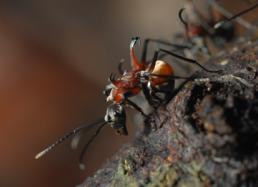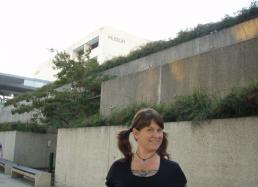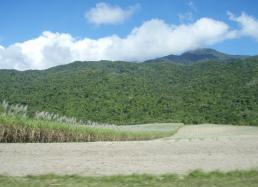7: Rainforest Conservation
Before leaving Townsville at the southern end of the Australian Wet Tropics, I spent a few days working with several of my collaborators at James Cook University. Visiting the JCU campus is always a treat, since it’s still in the tropics and the plant and animal diversity on the college campus is amazing.
Several male Great Bowerbirds (Chlamydera nuchalis) make the campus their home. Bowerbirds are known for the intricate “bowers” (ground nests) that the males make to attract mates. These bowers are usually constructed with twigs to form two walls that provide an avenue area.
But what is often the most eye-catching aspect of these bowers is the décor—brightly colored objects that the male carefully arranges on the ground around and within his bower. These objects can include shells, rocks, broken glass, leaves, feathers, berries, coins, and bits of discarded plastic. As you can see in the above photo of the bowerbird nest that I found on campus, this bird seems to prefer white snail shells and pieces of green glass as his decorating motif.
Again, the diversity of plant and animal life on campus never ceases to surprise me—there are several species of spiny ants right outside the door of the biology building (see Photo #1 below)! I hope that my research on ants will contribute to our understanding of why there is so much biological diversity in tropical habitats like this one, all around the world.
Here in Australia, not only have I gotten to see an extraordinary diversity of ants, but I have also been fortunate to collaborate with some of the best ant biologists in the world. That’s one of the greatest parts of traveling to new places to conduct scientific research—working with local scientists and knowing that efforts to protect natural resources are well supported by in-country researchers and activists.
At the end of our trip, an aerial view of the Australian Wet Tropics during our short flight to Brisbane gave us an opportunity to realize anew the environmental stresses facing the rainforests (see Photo #3 below.) Overall, Australia is working hard to protect and preserve their rainforest habitats. But climate change, human encroachment, and deforestation to make room for crops and cattle still threaten not only the AWT, but also tropical forests all around the world.
I hope that by exploring the AWT with me, you’ve seen the value in preserving these beautiful rainforests and their unique inhabitants. I’d also like to invite you to make a difference by contributing to our research and conservation efforts via a Restricted Gift to Zoology. As you know, cataloging the diversity of species in threatened areas and devising strategies that protect this diversity can be a financial challenge, so we thank your for your desire to support The Field Museum’s mission!
And stay tuned … after I’ve returned home to the museum, processed my specimens, and analyzed the ant DNA, I’ll send out one more dispatch that explains what I’ve learned so far. I’ll also have video footage showing exactly how I process DNA in the museum’s DNA Discovery Center and what these genetic studies tell us about the ant family tree and climate change.
Until next time,
Dr. Corrie Moreau






